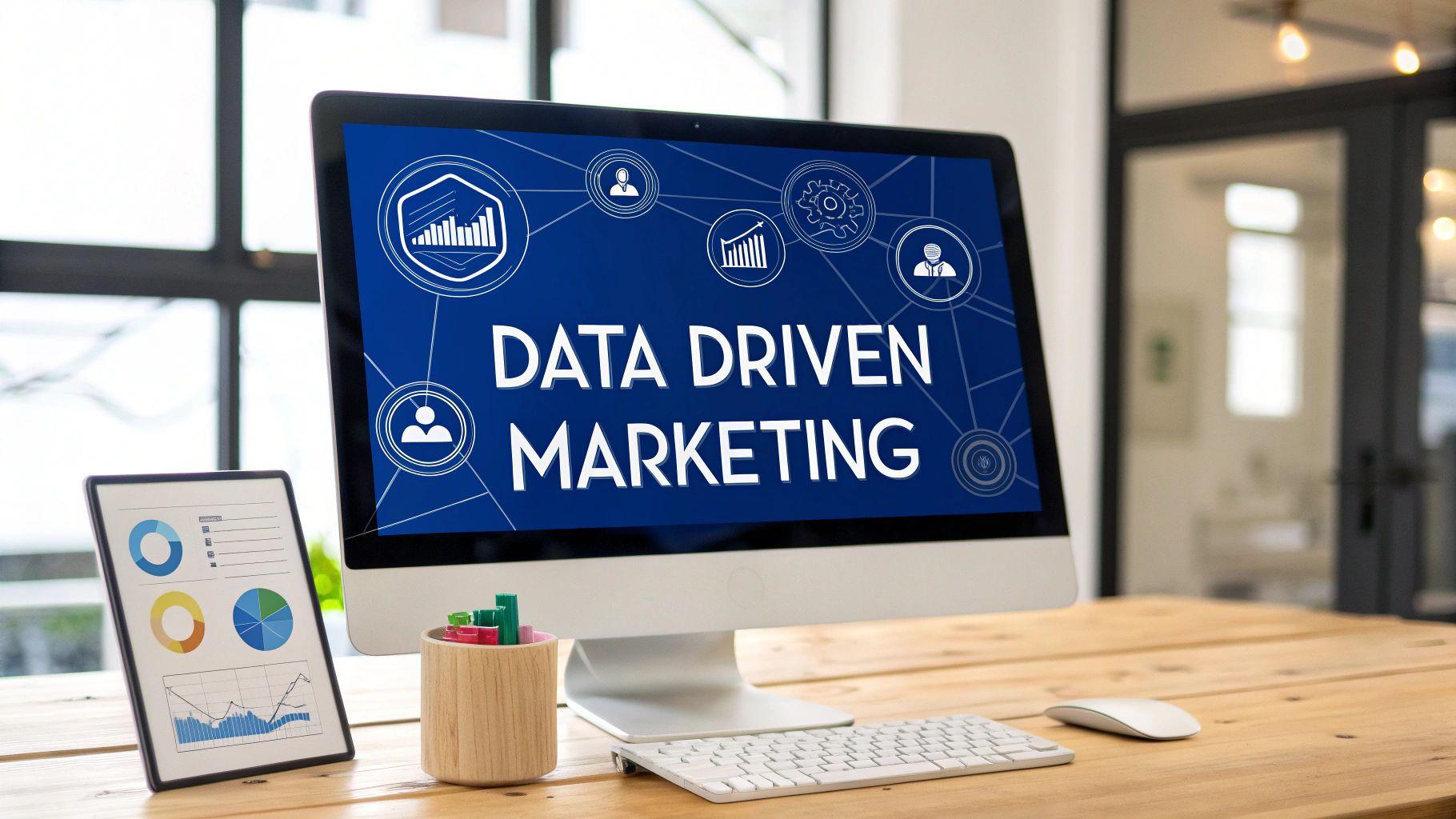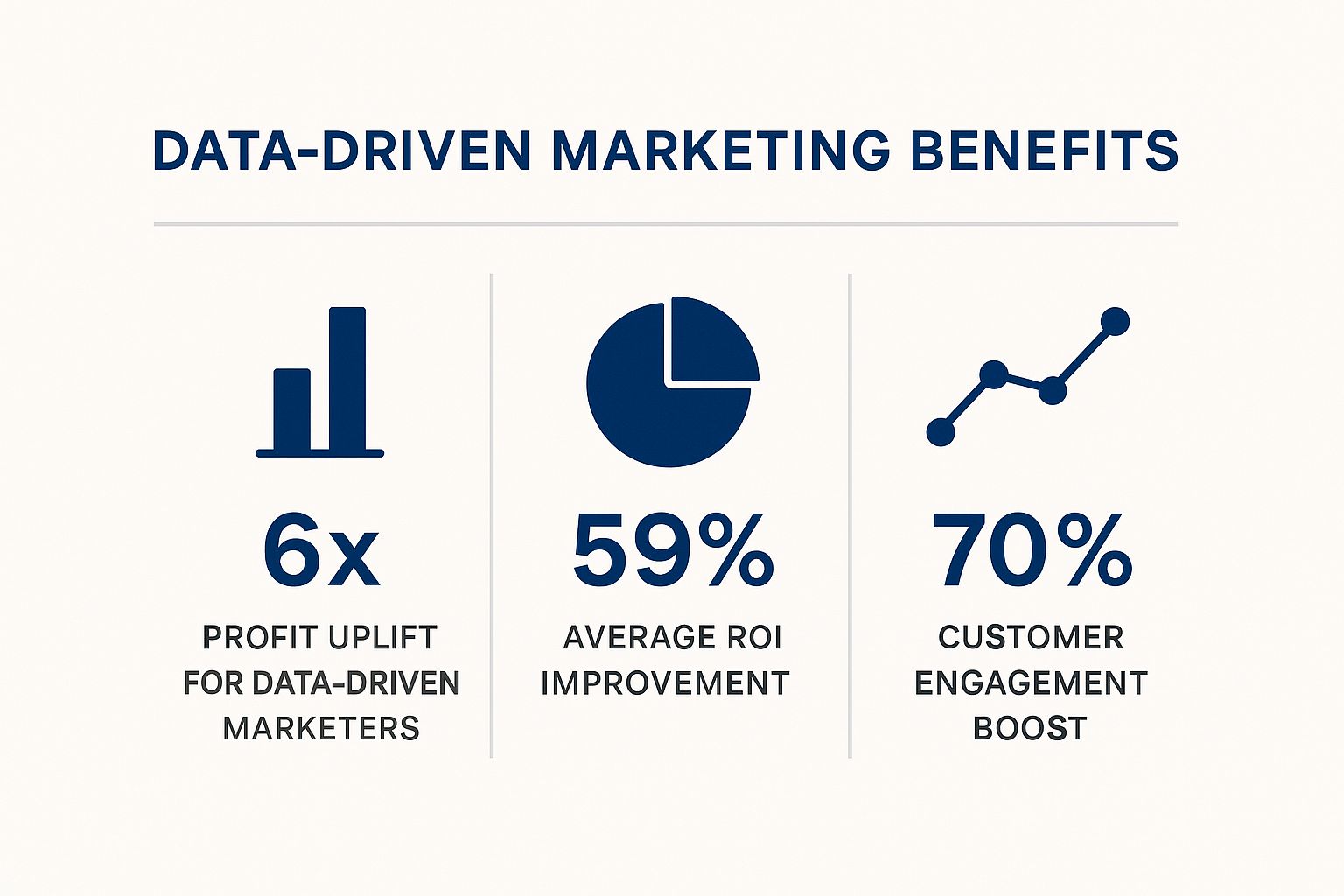Data Driven Marketing Strategies That Drive Profit, Not Just Clicks
Discover data driven marketing strategies that fuel profitability. Learn how to turn customer insights into actionable results and sustainable brand growth.

Data-driven marketing isn't about hoarding spreadsheets. It's about turning customer intelligence into smarter, more profitable decisions. This approach replaces guesswork with evidence, transforming every marketing action—from ad creative to product development—into a calculated move designed for maximum impact and sustainable scale.
Beyond Buzzwords: What Data-Driven Marketing Really Means
Let's cut through the noise. Data-driven marketing is a strategic pivot from campaigns based on gut feelings to a system where real-world performance metrics steer the ship. It’s the difference between launching a product because it feels like a good idea and launching it because customer search data, competitor analysis, and PPC test results all point to a clear, untapped market opportunity. If you want to go deeper, this guide on what data-driven decision-making truly entails and its importance for your business is a great resource.
This shift turns marketing from a cost center into a powerful growth engine. Instead of just spending money on ads, you're investing in market intelligence.
For an eCommerce brand, a well-run Amazon PPC campaign does more than just drive sales. It delivers priceless feedback on:
- Keyword Performance: Which search terms are people actually using to buy? This reveals true customer intent and fuels your organic SEO strategy.
- Creative Effectiveness: Which product images or ad headlines earn the most clicks and conversions? This is direct, unfiltered feedback on your brand creative.
- Price Sensitivity: How do conversion rates change when you test different price points or promotional offers?
This real-time data becomes the bedrock for your broader business strategies, fueling everything from your organic search rankings to your next product development cycle.
The Shift From Traditional To Data-Driven Marketing
To really grasp the change, it helps to see the old and new approaches side-by-side. The table below breaks down the fundamental differences in mindset, methods, and outcomes.
| Aspect | Traditional Marketing Approach | Data-Driven Marketing Approach |
|---|---|---|
| Foundation | Intuition, experience, "gut feelings" | Hard data, real-time analytics, A/B tests |
| Audience | Broad demographic segments (e.g., "women 25-40") | Hyper-specific personas based on behavior |
| Campaigns | "Set it and forget it" for a fixed duration | Continuous optimization and iteration |
| Measurement | Vague metrics like "brand awareness" or "reach" | Concrete KPIs like CPA, ROI, LTV |
| Personalization | One-size-fits-all messaging | Dynamic, personalized content for each user |
| Decision-Making | Based on past campaign success or failure | Based on predictive models and live feedback loops |
As you can see, the data-driven model is dynamic and responsive, built to adapt and improve over time, while the traditional approach is far more static.
The Performance-First Philosophy
This move toward data-driven marketing is non-negotiable for modern retail leaders. A 2025 survey of marketing executives found that 64% strongly agree that it's crucial in today’s economy. This trend has only accelerated as restrictions on third-party data tighten, forcing brands to master their own first-party data to see what’s actually driving profitable sales.
The image below lays out the tangible business results when marketing decisions are backed by hard numbers.

These figures make it crystal clear: embracing data isn't just a trend. It's a direct route to higher profits, better ROI, and customers who stick around.
Headline's Takeaway: Data-driven marketing is an active, performance-first framework, not a passive activity. It uses paid channels like PPC as a strategic tool to gather market intelligence. That intelligence then fuels organic growth, boosts profitability, and helps build a sustainable, scalable brand. It’s all about making smarter bets with your marketing dollars, where every campaign is a chance to learn, refine, and drive better bottom-line results next time.
Building Your Foundational Data Strategy
Exceptional data-driven marketing isn't magic; it's built on a solid foundation. You wouldn't build a house on soft ground. You’d pour a deep, solid concrete foundation to support the entire structure. For your brand, that foundation rests on three pillars: First-Party Data Collection, Customer Behavior Analysis, and Performance Metrics Integration.
Getting each one right is the key to turning raw information into profitable action. Without this structure, you're just hoarding data; with it, you're building a powerful strategic asset.

Pillar 1: First-Party Data Collection
First-party data is the information you gather directly from your audience. It's the most valuable data you can own because it’s accurate, relevant, and exclusive to you. But a simple "sign up for our newsletter" form isn't a strategy. The goal is to create a value exchange where customers want to share their information.
Of course, this is worthless if your data is a mess. To avoid skewed insights and wasted ad spend, implementing data quality best practices is non-negotiable. This ensures the information you’re collecting is clean, accurate, and ready for activation.
Here are a few practical ways to gather rich, actionable first-party data:
- Interactive Quizzes: A quiz like "Find Your Perfect Skincare Routine" does more than engage. It collects specific data on needs and preferences you can use immediately for personalization.
- Loyalty Programs: These are goldmines. They directly link purchase history and engagement to individual customers, revealing exactly who your most valuable shoppers are and what they buy.
- Post-Purchase Surveys: Don't just ask for a star rating. Ask targeted questions like, "What was the main reason you chose us over a competitor?" This delivers priceless competitive intel straight from the source.
Pillar 2: Customer Behavior Analysis
Once you have the data, the next step is uncovering the "why" behind it. Customer behavior analysis is about observing how people actually interact with your brand online. This is where you uncover hidden friction points and identify your biggest growth opportunities.
Your website is a treasure map of user intent. Your job is to find the clues that explain why someone did—or didn’t—buy. This requires going beyond basic metrics like page views and bounce rates.
Raw data tells you what happened, but behavioral analysis tells you why. A high cart abandonment rate is a "what." Session recordings showing users getting confused by your checkout flow is the "why."
To get these kinds of insights, a couple of tools are indispensable:
- Heatmaps: These give you a visual map of where people are clicking, moving, and scrolling. You can see in an instant what’s catching their eye and what they’re completely ignoring.
- Session Recordings: Watch anonymous recordings of real user sessions. It’s the single best way to see your website through your customers' eyes and spot usability issues you never would have noticed.
Pillar 3: Performance Metrics Integration
The final pillar ties everything back to what really matters: profitable growth. Too many brands get lost in vanity metrics like impressions or even top-line revenue. A performance-first approach focuses on the numbers that truly measure the health and scalability of your business.
Every ad click isn't just a potential sale; it's a data point that refines your understanding of what drives profitable growth.
Focus on integrating and constantly tracking these key performance indicators (KPIs):
- Customer Acquisition Cost (CAC): How much does it really cost to acquire a new customer? Knowing this is the first step toward scaling profitably.
- Customer Lifetime Value (LTV): How much profit does an average customer generate over their entire relationship with your brand? The goal is simple: ensure LTV is significantly higher than CAC.
- Return on Ad Spend (ROAS): For every dollar you put into advertising, how much revenue do you get back? This is the clearest measure of campaign efficiency.
When you build your strategy on these three pillars, you create a powerful feedback loop. You collect clean data, analyze it to understand your customers, and measure the results against the metrics that actually drive sustainable scale. This is the blueprint for a truly data-driven marketing machine.
Turning Customer Insights Into Revenue
Collecting data is just the starting line. The magic happens when you use those insights to grow your business. This is where performance-first personalization comes in—moving beyond plugging a first name into an email and into smart, data-driven strategies that produce measurable results.
The goal is to make every customer feel like you're speaking directly to them, but at scale. It’s about showing them the right product at the right time with a message that resonates. This isn't a customer service nice-to-have; it's a core revenue driver.
From Data Points to Personalized Experiences
Think of your customer data as clues. Every product they viewed, purchase they made, or cart they abandoned is a hint about their wants and needs. Your job is to piece those clues together to build a smooth, personalized experience that leads them to purchase.
At the core of this is the ability to pull usable intelligence from different sources. Using comprehensive customer experience analytics is how you turn a spreadsheet of numbers into a clear picture of customer behavior.
Here are three powerful ways you can put this into action right away:
- Dynamic Product Recommendations: If a customer browsed hiking boots, your homepage and subsequent emails should feature your best-selling boots, wool socks, or a blog post about local trails. This is exponentially more effective than a generic "new arrivals" banner.
- Behavior-Triggered Email Campaigns: Ditch the rigid weekly newsletter schedule. Set up automated emails based on customer actions. The classic cart abandonment email can claw back a huge amount of lost revenue with a simple, timely nudge.
- Personalized Ad Creative: Use your data to build specific audience segments. For example, Amazon's data from past purchases and browsing history can power Sponsored Display ads that target users with hyper-relevant products, seriously boosting conversion rates. A customer who bought a beginner’s camera kit can be retargeted with ads for intermediate lenses, ensuring every ad dollar hits a relevant target.
The Financial Impact of Smart Personalization
When you get these strategies right, the payoff is huge. A well-known report from McKinsey found that personalization can lift revenues by 5% to 15% and make marketing spend 10% to 30% more efficient. Those numbers explain why 47% of marketers say email is their top channel for executing data-driven tactics.
This is especially true on crowded platforms like Amazon. For example, a sports nutrition brand we work with uses past purchase data to create targeted Sponsored Display campaigns. Customers who previously bought whey protein are shown ads for complementary products like creatine or pre-workout. This simple, data-driven tactic increased their repeat purchase rate by 22% in a single quarter. Our guide on how to increase Amazon sales gets into the nitty-gritty of these kinds of platform-specific strategies.
Headline's Takeaway: Real personalization is about relevance, not just recognition. It’s using data to anticipate a customer's needs and present a solution before they even ask. By automating this with dynamic content, triggered campaigns, and smart ad segments, you build a powerful marketing engine that turns insights directly into revenue.
Using PPC as Your Primary Data Engine
For many brands, Pay-Per-Click (PPC) advertising is a straightforward sales tool. You put money in, you get conversions out. This thinking is a massive missed opportunity. To truly adopt a data-driven approach, you must see PPC as something more: a real-time R&D lab for your entire business.
Platforms like Amazon and Google provide a direct line to your customers. Instead of spending a fortune on focus groups or waiting months for survey results, you get immediate, actionable feedback from real people clicking and buying in the wild.
Turning Clicks Into Competitive Intelligence
Every component of a PPC campaign is a data point. When you learn to read between the lines, you can test assumptions about your market, products, and messaging on the fly. You just have to look beyond surface-level vanity metrics.
Here’s a glimpse of what you can uncover:
- Ad Copy Effectiveness: Which message actually drives clicks? Run ads with different headlines. If an ad promising "durability" achieves a much higher click-through rate (CTR) than one focused on "style," you've just learned what your customers truly value.
- Keyword Intent: A keyword might get a ton of clicks, but does it lead to sales? High-converting keywords are pure gold. They tell you exactly what search terms lead to revenue, which is invaluable for dialing in your organic SEO strategy.
- Visual Appeal: A/B test your product images. The image that gets the most engagement in an ad is likely the one you should feature on your product detail page and across all marketing channels.
This Amazon Ads dashboard provides a perfect snapshot of the kind of data you can access.

You can instantly see your spend, sales, and ROAS. This isn't just about ads; it's a clear signal telling you which campaigns are working and which need a rethink.
Fueling a Cycle of Continuous Growth
The insights from PPC shouldn't stay siloed in your ad account. They must feed back into your overall business strategy—influencing everything from product development to brand voice.
Let's say a specific, long-tail keyword in an Amazon campaign has an incredible conversion rate. That’s a massive clue pointing to a gap in the market. For one of our clients in the home goods space, we discovered through PPC data that "pet-safe air freshener" was converting at 3x the account average. This single data point justified creating a new landing page, a dedicated blog post, and ultimately, a new product line targeting that niche audience. Our complete guide to Amazon PPC gets into the nitty-gritty of building this kind of strategic flywheel.
When you treat PPC as an R&D tool, you're no longer just spending money on ads. You're making a strategic investment. Every campaign becomes a low-cost experiment that delivers high-value insights, taking the guesswork out of your bigger business decisions.
This is what a performance-first mindset is all about. Companies that truly get this right often see five to eight times the ROI on their marketing spend. Why? Because they're always learning and adapting. Your PPC campaigns are the fastest, most reliable way to feed that cycle of improvement.
Stop thinking of PPC as just a sales channel. Start treating it like the powerful data engine it is. The real-time market feedback you get is one of the most valuable assets you have for building a smarter, more profitable brand.
Building Your Data-Driven Marketing Tech Stack
A great data-driven strategy is just an idea without the right tools to bring it to life. Putting together a powerful marketing tech stack isn’t about buying the most expensive software; it’s about creating a connected system that gives you one clear, complete picture of your customers and performance.
Without an integrated stack, your data gets trapped in silos. Your paid search data won't talk to your email list, and your website analytics won't inform your next creative. A well-built stack fixes this, creating a virtuous cycle where insights from one channel fuel improvements in another.
Core Components of a Modern Tech Stack
To build a stack that actually helps you grow, you need to cover a few key areas. These tools work together to pull in customer data, make sense of it, and help you act on it. This is how raw numbers turn into real revenue.
- Analytics & Reporting: Think of this as your mission control. Everyone starts with a tool like Google Analytics 4 to get a handle on website traffic and user behavior. For eCommerce brands, though, tools like Triple Whale are becoming essential. They pull together data from all your ad platforms to give you a single, honest look at your marketing ROI.
A dashboard like this one from Google Analytics gives you a quick, visual gut-check on your traffic and where it’s coming from.
At a glance, you can spot your best-performing channels and see what people are doing on your site right now.
- Customer Data Platforms (CDPs): A CDP is the brain of your entire data operation. It pulls first-party data from every place a customer interacts with you—your website, email campaigns, ad clicks, even customer service chats—and stitches it all together into one single profile for each person. This unified view is the secret sauce behind true personalization.
Powering Personalization and Performance
Once you have a solid data foundation, you can start layering on tools that turn those insights into action. This is where your tech stack starts to directly shape the customer experience and drive sales.
Personalization engines and other specialized management tools are no longer a "nice-to-have," especially for larger brands. In fact, a recent report found that nearly 71% of large brands with ad budgets over $1 billion see AI-powered personalization as the single biggest trend shaping their business in 2025.
This shows a huge industry shift toward tech that delivers measurable results. You can read the full report on data-driven marketing trends to see exactly how the big players are thinking about their budgets.
Picking the right tools can feel overwhelming, so here’s a simple breakdown of the essential categories and some top players in each.
Essential Tools for Your Data-Driven Tech Stack
| Tool Category | Core Function | Example Platforms |
|---|---|---|
| Analytics & Reporting | Tracks website traffic, user behavior, and campaign performance to measure ROI. | Google Analytics, Triple Whale, Mixpanel |
| Customer Data Platform (CDP) | Consolidates customer data from multiple sources into a single, unified profile. | Segment, Bloomreach, Klaviyo |
| Email & SMS Marketing | Automates and personalizes communication through email and text messages. | Klaviyo, Attentive, Postscript |
| PPC & Ad Management | Manages paid advertising campaigns across search and social media platforms. | Google Ads, Meta Ads Manager, AdRoll |
| SEO & Content | Optimizes website content to improve organic search visibility and rankings. | Ahrefs, Semrush, Clearscope |
Ultimately, your goal is to find tools that not only do their job well but also integrate smoothly with the rest of your stack.
Headline's Takeaway: Building your tech stack is about integration, not just collection. The real magic happens when you create a closed-loop system where data flows freely. Performance data from your ad platforms should feed your personalization engine, which is then measured by your analytics tools. This connectivity is what turns a bunch of separate marketing tactics into a single, powerful growth machine.
Putting Your Strategy to Work and Measuring What Matters
A strategy is just a document until you execute. This is where data-driven plans leave the whiteboard and enter the real world, turning insights into measurable growth. The key is to stop thinking of "implementation" as a one-time launch. It's a continuous cycle: test, learn, and scale.
First, you need a baseline. A full data audit is step one—an honest look at your data sources, tools, and the quality of the information you're gathering. You can't draw a map to your destination if you don't know where you're starting.

Defining Your North Star Metrics
Once you know what data you have, you must define what "success" actually looks like. Too many brands chase vanity metrics—like impressions or even total revenue—which can easily mask serious profitability problems. To grow sustainably, focus on KPIs directly linked to business health.
The goal is to shift from measuring activity to measuring impact. This means building a culture where every decision is challenged and validated against the right numbers.
Here are a few essential metrics to build your strategy around:
- Customer Lifetime Value (LTV) to Customer Acquisition Cost (CAC) Ratio: This is the ultimate report card for your marketing. A healthy ratio, ideally 3:1 or better, proves you’re not just acquiring customers, you’re doing it profitably.
- Marketing Efficiency Ratio (MER): This provides a high-level, honest look at performance by dividing your total revenue by your total marketing spend. We break down why this is so important in our complete guide to the Marketing Efficiency Ratio.
- Contribution Margin: This tells you the profit from a product after subtracting the variable costs to produce and sell it. It ensures your ad spend drives actual profit, not just top-line revenue.
The Test-Learn-Scale Flywheel
With your data and KPIs locked in, it’s time to execute. The smartest data-driven marketers don't bet the farm on a new idea. They operate like scientists, running small, controlled experiments to prove a hypothesis before scaling investment.
This "Test-Learn-Scale" model is a simple, powerful loop that minimizes risk and maximizes returns. It's the engine of a resilient marketing operation.
- Test: Formulate a clear hypothesis. For example: "We believe ad creative featuring user-generated content will achieve a 20% higher click-through rate than our studio photos on our target audience." Run a small A/B test to get clean data.
- Learn: Analyze the results. Did the new creative lead to more profitable sales, or just more clicks? Document the findings—wins and losses both provide valuable intelligence.
- Scale: If the hypothesis was correct, confidently roll out the winning creative across broader campaigns. If it failed, apply the learnings to your next hypothesis and restart the cycle.
This is what a real data-first culture looks like. It’s about creating an environment where curiosity is encouraged, failure is seen as a learning opportunity, and decisions are backed by numbers, not just opinions.
This disciplined approach transforms marketing from a series of disconnected campaigns into a smart, connected growth engine. Every dollar spent becomes an investment in getting smarter, steadily improving your ability to acquire the right customers and grow the business profitably.
Frequently Asked Questions
Even the sharpest eCommerce leaders have questions when digging into a data-first marketing approach. Here are some of the most common ones we hear, with no-nonsense answers to help you move forward.
How Do I Start With a Limited Budget?
A small budget isn't a handicap; it’s a filter. It forces discipline and a ruthless focus on what actually works. Think like a scientist, not a gambler.
Forget spreading your money thin across a dozen channels. Pick one—like Google Ads or Amazon—and master it. Use that small budget to run hyper-focused A/B tests on ad copy, creative, and high-intent keywords. Your goal isn't massive reach; it's rapid learning. Every dollar spent should buy you data that makes your next dollar work twice as hard.
What Are the Most Important Metrics to Track?
Ditch the vanity metrics. Impressions and clicks look nice on a report, but they don't pay the bills. For any eCommerce business, there are only three numbers that tell the true story of performance:
- Customer Acquisition Cost (CAC): How much does it cost to acquire one new customer?
- Customer Lifetime Value (LTV): How much profit does one customer generate over their entire relationship with your brand?
- Marketing Efficiency Ratio (MER): Your total revenue divided by your total ad spend. It's a fantastic, high-level view of what's working.
Focusing on these three automatically forces decisions based on profitability, not just top-line revenue. That is the key to building a business that lasts.
How Can I Ensure Data Privacy and Build Customer Trust?
In today's privacy-conscious world, transparency is your most powerful tool. Being upfront about what data you collect and why isn't just a legal requirement—it's one of the best ways to build brand loyalty.
The new rule is simple: if you can’t explain to a customer in plain English why you need their data, you shouldn’t be collecting it. This mindset builds trust and flips privacy from a compliance task into a competitive advantage.
In practice, this means having a readable privacy policy, using data to genuinely improve the customer's experience (like offering truly helpful product recommendations), and never selling your first-party data. When customers see you're using their information responsibly to make their lives easier, they will reward you with their business.
At Headline Marketing Agency, we turn raw data into a dominant marketplace advantage. Our team builds and executes data-driven advertising strategies on Amazon and beyond, focused on the only thing that matters: your profitability and long-term growth. It's time to stop guessing and start scaling with a partner who turns insights into impact.
Wollen Sie Ihre Amazon PPC-Performance aufs nächste Level bringen?
Lassen Sie Ihre Amazon PPC-Kampagnen professionell analysieren und entdecken Sie neue Wachstumsmöglichkeiten.